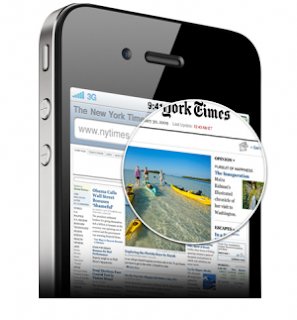
Mobile journalists, or "mojos," are a natural progression of the advent of smart phones and the massive downsizing of news organizations. Armed with smart phones, adequate knowledge of the latest tech trends and a good story to tell, these mobile journalists are replacing whole news teams.
Neal Augenstein, an award-winning radio reporter for WTOP in Washington DC, is one of this new breed. For the past year and a half, he has done all of his reporting in the field using his iPhone. IJNet attended his webinar entitled “iPhone Reporting, Techniques, Tips, Strategies” to learn his tricks. (Follow Augenstein on Twitter for news on upcoming seminars.)
Here are IJNet's top takeaways from the webinar.
1. Use your iPhone for multi-layered audio editing. With an app like VeriCorder, reporters can cut, edit and assemble audio clips on a multi-layered track screen. The finished report can be then emailed instantly to your newsroom from your iPhone. Augenstein now depends entirely on the built-in iPhone microphone after experimenting with a number of mini-microphones. Augenstein’s recommendation for an external microphone is the Blue Mikey, it connects directly to the iPhone charging port, although it is not compatible with the iPhone 4. Augenstein declares himself satisfied with the audio quality produced by his smart phone: “Compared to speaking with broadcast quality, the audio is 92 percent as good,” he says. Augenstein demonstrates how he uses VeriCorder for audio editing in a video here.
2. Don’t accept phone calls. If you're recording during an event or a press conference, you can place your iPhone on the podium, but remember to set it on “airplane mode" since receiving phone calls will stop the VeriCorder from recording.
3. Improvise. There are currently no microphone lifts for the iPhone, so Augenstein uses super glue to attach a piece of foam inside the regular microphone clip. “This way it holds the iPhone without scratching the surface,” Augenstein notes.
4. Accessorize. If you're recording video, getting good audio is tricky using just an iPhone since the built-in microphone points away from the interviewee who may be standing several feet from you. To solve this problem, Augenstein uses an XLR adapter, which substantially improves the quality of video recording. You may also want to invest in an extension speaker to hear yourself better as you record. Also, to overcome the issue of short iPhone battery life, Augenstein always carries a charger that plugs into his car lighter so his smart phone juices up when he's on the road.
5. Skype it. For live audio reports, the Skype mobile app is your best option. It has a better signal than a regular cell phones if you are on the road. Also, remember that wi-fi provides a better audio quality than 3G connections. Make sure to mention that you are using Skype especially if you are using a 3G connection.
6. Video stream from your phone. To live video stream from your phone, go to Ustream, sign up, then download the Ustream broadcasting app for your iPhone. When you're out reporting, open the Ustream app, then press the “go live” button and your recording will go live on the Ustream page. Ustream also provides an embed code that can be uploaded to your company website. You can also share links to your live reports on social media sites like Facebook and Twitter.
7. Quick photo editing. If you're in a rush to send a picture to your newsroom and don’t have time to use edit it with apps, use the iPhone 4’s built-in camera. Select the picture you want to edit from your Camera Roll, reframe it using your fingers, then take a screenshot of the cropped image by simultaneously touching the on/off button on the top of the phone and the Home button. If you are happy with the cropped image, simply email it.
8. Tweet it. Use your Twitter account to share your reports with the public. “It is one of the easiest way to get your reports out there,” says Augenstein. “And it's very easy to tweet an audio or video.” The new operating system for the iPhone, iOS5, expected to be released this fall, should also make tweeting files much easier.
![জাতীয় মাসিক মুক্তিদূত [The Monthly Muktidooth] Print / Online media](https://blogger.googleusercontent.com/img/b/R29vZ2xl/AVvXsEheZeyeCPuv2K1w9aQS2nHWV-Ki7imLNafgoioYVk4VZOfndJAVa8cVymXVqq0IgoV78UomPEs5fIhc1oWspL95p61bdR7h1G6ek5D4iBvmKuMFjkDB_PrWbTmGlbchnV_JR2bxl_YRkszy/s320/muktidoothLogo.jpg)
No comments:
Post a Comment